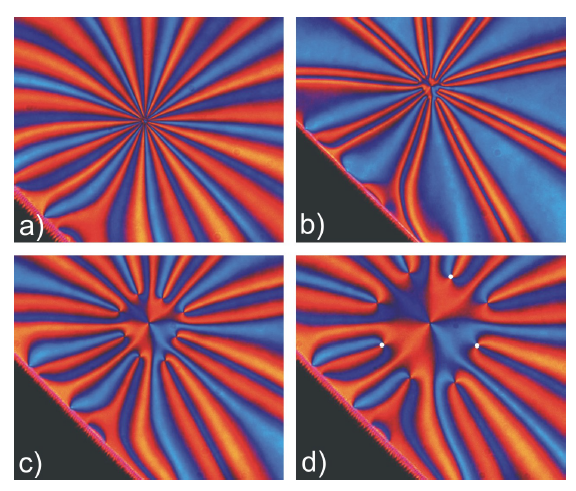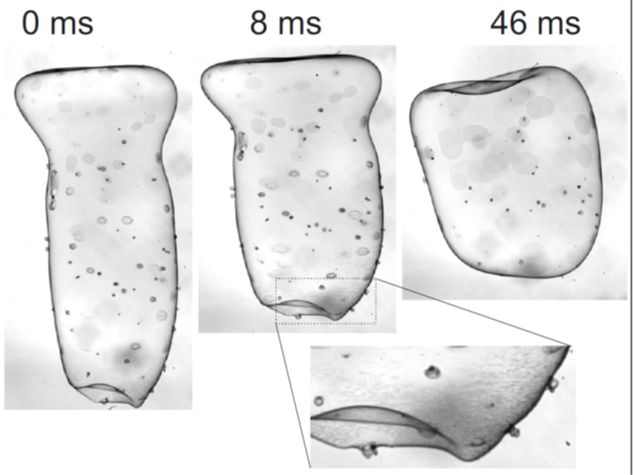Current topics
Research topics
- Thin fluid films and membranes
Smectic freely suspended films can be generated as closed bubbles just like soap films. They represent a unique system that combines properties of soap bubbles and vesicles. In these systems, among other things, we investigate the shape dynamics of the bubbles (bottom left image). Closely related to this topic is the observation of spontaneous protrusions and regular wrinkling in response to external forces (bottom center image). The latter represent an example of spontaneous dynamically self-organized patterns. Most of these experiments are performed under microgravity conditions on free-floating bubbles. We use high-speed imaging to study the rupture of liquid films (bottom right image).
Example: Shape dynamics of freely floating smectic bubbles, rupture dynamics
Left image: Cover page of the journal Soft Matter with examples of free-floating smectic bubbles. Center image: Free-floating smectic bubble during axial compression (vertical in the image) with protrusions and wrinkling at the lower end. Width of the images approx. 2 mm. Right image: rupturing smectic bubble with filament formation of the rupturing front, width of image about 3 mm..
- Pattern formation and self organization in nonlinear systems
We study self-assembled structures in soft matter systems. Previous studies involved the experimental and analytical description of electrically driven convection rolls (ElectroHydrodynamic Convection, EHC) in nematic liquid crystals and in free-standing smectic films. In these systems, among other things, we have studied nonclassical EHC instabilities, the influences of noise excitation, and the influence of superimposed harmonic and other excitations. One of the topics was the characterization of the systems under time inversion of the excitation modes. Another focus was the study of Faraday waves in liquids mechanically driven by vertical vibrations in shallow vessels. Superimposed excitation functions as well as time-reversed excitation sequences were also studied in this system. Some experiments have been performed on thermally driven convection in thin smectic liquid crystal films. Current focuses are mechanically induced wrinkling and protrusions of free-floating smectic films, and self-assembly of droplets on smectic films in the form of colloidal crystals.
Example: Spontaneous wrinkling in laterally compressed smectic films (Harth et al., Soft Matter 17 6761 (2019))

Figure: Spontaneous wrinkle formation of an axially compressed bubble, image width approx. 1 mm. The dynamic process of the formation of patterns of a preferred wavelength and the modeling of this instability is a focus of our investigations.
Example: Spontaneous self organization of droplets in freely suspended smectic A films (Klopp et al., Soft Matter 15 8156 (2019))
Droplets on a self-supporting film in the smectic A phase (here forming a smectic bubble) arrange themselves in a hexagonal lattice due to mutual repulsive forces. The left picture (a) shows a smectic bubble of about 15 mm diameter on the ISS in the state of weightlessness, one can identify regions of different film thicknesses, which can be distinguished by their interference colors. Antler-like structures seen in the upper part of the image are parts of the apparatus. The bubble is held by a capillary (in the lower part). The right image (b) shows a 500 micrometer wide section on which droplets are arranged in a locally hexagonal lattice. They form a two-dimensional colloidal crystal which, in contrast to many 2D colloidal crystals described in the literature (at liquid interfaces), does not have a liquid subphase
- Anisotropic fluids
Today, liquid crystals are indispensable in display technique and many other fields of application. They also play a major role in fundamental research on anisotropic systems. One of the current research topics of the group is the investigation of topological defects, i.e. irregular points of the orientation field of such fluids. We perform studies in freely suspended smectic films, which are an exceptional and convenient example of a quasi-two-dimensional fluid. Dynamic processes can thus be observed in a 2D geometry. We investigate the interactions of topological defects and the mutual spontaneous annihilation of pairs of defects of opposite topological charges.
Example: Interactions of topological defects, defect annihilation



Image left: Cover of the Journal EPJ E showing a group of topological defects captured in a thinner film region. Middle image: Nine defects each with topological charge +1 are initially held in a thin film region (a), then this region is destroyed (b) and eight defects move away from each other due to their mutual repulsive forces (c,d). One of the defects remains in the center. Right picture: Two defects with opposite topological charges +1 and -1. Such pairs annihilate each other.
- Structure and dynamics of granular materials and suspensions
The outflow of granular materials from containers with narrow openings at the bottom has been practically applied in silos and other storage vessels for centuries. However, the dynamics of this process are poorly understood. Theoretical predictions exist essentially only for the simple case of monodisperse hard spheres. The focus of our investigations is the silo discharge of shape anisotropic particles (rods, ellipsoids, platelets as well as other, more complex, also non-convex shapes) and the investigation of the influence of friction and the elasticity of the particles on the outflow behavior. Other experiments in previous projects dealt with the mixing or segregation of granular materials in rotating mixers and the occurrence of spontaneously formed spatial structures that exhibit aging dynamics (coarsening of the patterns) over time until complete segregation. Another topic of investigation is the arrangement of regular particles (especially spheres) in containers under geometric constraints. Further experiments concern the packing behavior of complex particles (crosses) in a two-dimensional plane..
Example: Crosses in a random two-dimensional packing
Figure: Four examples of randomly packed crosses in a plane. The most important parameter is the ratio of the arm width b to the arm length a of the crosses (Stannarius & Schulze, arxiv.org). Theoretically, one finds complete area filling for the ratios b/a = 1, b/a = 2, and a = 0 (squares). Realistically, we find coverages between 50% and 70%, well below the bounds for optimal regular packings.
Example: Frustrated packing of monodisperse spheres in a flat container
In a container only slightly thicker than the diameter of the spheres it contains, a frustrated packing is formed. On average, half of the spheres are in contact with the front side of the container and the other half are in contact with the rear side. This system has much resemblance to frustrated antiferroelectric spin systems on a triangular lattice (Wannier 1950) . The two layers are indicated by different shades of gray in the image above. The system usually never reaches its multiply degenerate ground state, but assumes states in which 13 local configurations occur with different weights. The statistics do not change even if the system is disturbed from the outside by mechanical excitations.
- Experiments with granular materials under microgravity
In addition to the investigations of granular solids and liquids, i.e., systems in which the neighboring particles have permanent contacts with each other, we investigate granular gases, i.e., systems in which the particles move isolated from each other and interact only occasionally through collisions. These experiments are performed on different platforms under microgravity, in the drop tower of ZARM in Bremen or on suborbital rockets.
Investigation of the cooling of granular gases in a drop tower experiment (GAGa) (Harth et al. PRL 120 21401 (2018)). The left image shows a box with two vibrating walls used to mechanically excite an ensemble of rod-shaped particles about 1 cm long during free fall. After the excitation is switched off, the system permanently loses energy due to inelastic collisions of the particles, so-called cooling of the granular gas. Two cameras are used to observe the dynamics of the ensemble stereoscopically so that we can determine the kinetic energies (of the rotational and translational degrees of freedom) and the collision statistics. Furthermore, the spatial homogeneity of the system is investigated.
- Magdeburger Arbeitsgemeinschaft für Forschung unter Raumfahrt- und Schwerelosigkeitsbedingungen, MARS
This work group is a collaboration of Magdeburg scientists carrying out Microgravity experiments. We contribute experiments in the ZARM-drop tower, in parabolic flights, in suborbital rockets as well as on the International Space Station ISS.












